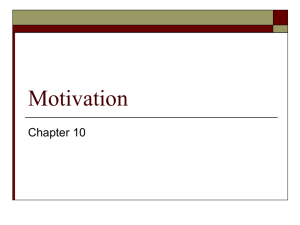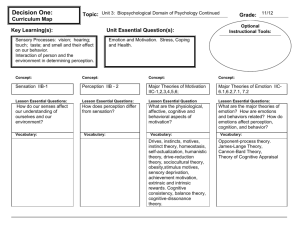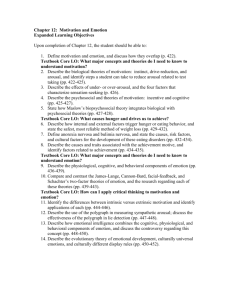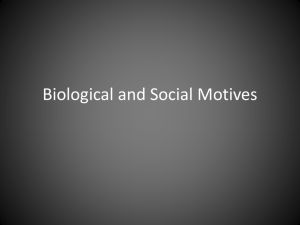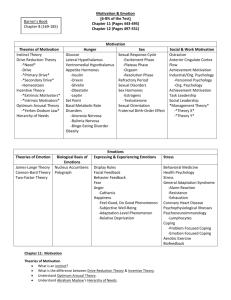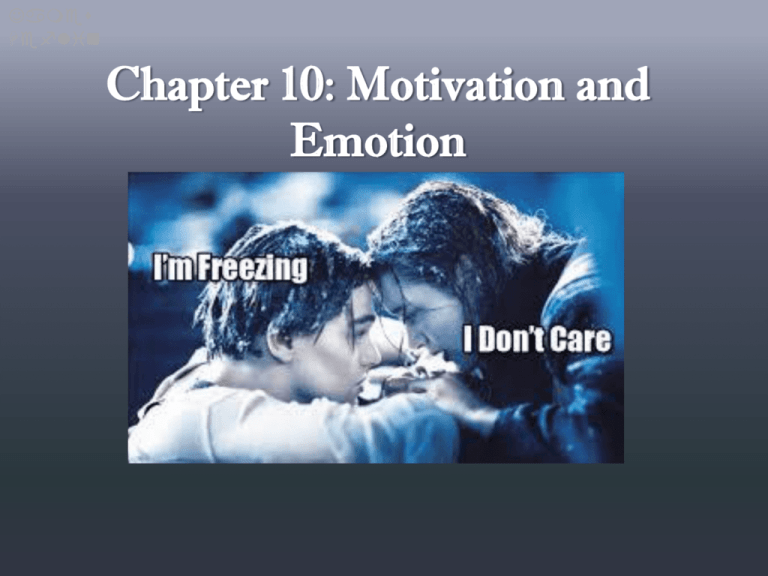
James
Heflin
Chapter 10: Motivation and
Emotion
Motivation and Emotion (6-8%)
In this part of the course, students explore biological and social factors that motivate
behavior and biological and cultural factors that influence emotion.
AP students in psychology should be able to do the following:
Identify and apply basic motivational concepts to understand the behavior of humans
and other animals (e.g., instincts, incentives, intrinsic versus extrinsic motivation).
Discuss the biological underpinnings of motivation, including needs, drives, and
homeostasis.
Compare and contrast motivational theories (e.g., drive reduction theory, arousal theory,
general adaptation theory), including the strengths and weaknesses of each.
Describe classic research findings in specific motivation systems (e.g., eating, sex, social)
Discuss theories of stress and the effects of stress on psychological and physical wellbeing.
Compare and contrast major theories of emotion (e.g., James–Lange, Cannon–Bard,
Schachter two-factor theory).
Why do we do what we do?
What
motivates
you? Let’s
Brainstorm!
https://www.
youtube.com
/watch?v=9h
dSLiHaJz8
Motivational Theories and
Concepts
Motives
needs, wants, desires leading to goal-directed behavior
Drive theories
seeking homeostasis ( a state of phsysiological equilibrium or
stability)
Drive (an internal state of tension that motivates an
organism to engage in activities that should reduce this
tension)
Drive Reduction Theory- physiological need creates a
psychological state that pushes the organism to behave in
ways to reduce the need
Cannot explain all motives (thirst for knowledge)
Primary Drive (biological needs)
Secondary Drive (learned- money can buy food)
Maslow’s Hierarchy of Needs (1943)
Physiological needs
to satisfy drives for
hunger, thirst, and
sex
Safety needs
to feel safe, secure,
and out of danger
Belonging and love
needs
to be accepted and
belong
Esteem needs
to achieve and to
gain approval and
recognition
Self-actualization
needs
to achieve your
unique potential
Incentive theories
Incentive (external goal that has the capacity to motivate behavior)
regulation by external stimuli
Push (internal) pull (external)
Intrinsic (internal) vs extrinsic (external)
Evolutionary theories
Natural selection favors behaviors that maximize reproductive
success
affiliation, achievement, dominance, aggression, and sex drive
INSTINCT THEORY- complex behaviors that aren’t learned & can
be explained by genetic predispositions
Arousal Theory
We seek an optimum level of excitement or arousal
some behaviors are motivating because they increase arousal
and vice versa
Yerkes-Dodson Law
We might perform well at an easy task at a very high arousal level
The same high level would worsen our performance on a difficult
task
Yerkes Dodson
Cognitive Consistency Theory
Motivation is produced from internal conflict
Cognitive Dissonance
Beliefs that are in opposition often produce conflict
(cognitive dissonance)
Beliefs counter to some behavior produces conflict
The individual is motivated to reduce conflict by
modifying or changing beliefs or behavior
Experiments in Lying
Achievement Motivation
A learned motive that promotes the individual to
find challenging tasks in which to succeed
Intrinsic v. Extrinsic Motivation
Internal motivation-motivation giving an individual satisfaction in and of itself
External motivation-motivation coming from a source outside oneself
Parenting Characteristics that enhance achievement motivation
Encourage children to attempt difficult tasks
Provide strategies for success
Give praise and appropriate rewards for success
Cultural Influences
Collectivist societies encourage group success
Individualistic societies encourage individual success
People Vary in Need for Achievement (refer to motivation theories)
Management Styles- Theory X vs Theory Y
Theory X managers assume that workers are lazy,
error prone and extrinsically motivated by money.
Theory Y managers assume that people are
intrinsically motivated, have pride in their work and
fulfill their potential.
What type of manager might you be?
Affiliation- need to be apart of a group
Affiliation- need to be apart of a group
In times of stress and fear, we tend to want to affiliate.
Too little affiliation (as in isolation) causes people to become
anxious.
Power- desire to have impact on other people
When Motives Conflict
1. When Motives Conflict
1. Approach-approach conflict
1.
2.
Avoidance-avoidance conflict
1.
3.
you must choose between two unattractive outcomes
Approach-avoidance conflict
1.
4.
you must choose between two desirable outcomes
one event or goal has both attractive and unattractive features
Multiple approach-avoidance conflicts
1.
you must choose between two or more things, each of which
has both desirable and undesirable features
Figure 10.2 The diversity of human motives
The Motivation of Hunger and Eating: Biological Factors
Brain regulation
Lateral hypothalamus
makes
you hungry; is lesioned rats do not eat (see rat
on right below)
Ventromedial hypothalamus
converts incoming food into fat, have to keep eating to
meet energy needs; if lesioned rats get fat. (see rat on
left below)
Contemporary theories focus more on neural circuits
that pass through the hypothalamus rather than on
the anatomical centers in the brain
Figure 10.3 The hypothalamus
Glucose and Digestive Centers
Glucose (simple sugar that is an important source of
energy
Glucostats ( neurons sensitive to glucose in the
surrounding fluid)
Some believe that glucostatic mechanisms may contribute to
the modulation of eating
Hormonal Regulation
Insulin (hormone secreted by the
pancreas), levels increase when
you eat, even the sight/smell can
cause secretion
Leptin (produced by fat cells and
provide information about the
body’s fat stores)
10 MINUTES TO STUDY
FOR YOUR READING
QUIZ
The Motivation of Hunger and Eating: Environmental
Factors
Learned preferences and habits
Palatability
Quantity available
Variety
Presence of others
When/how and cultural differences
Food-related cues
Appearance, odor, effort required
Stress
Link between heightened arousal/negative emotion and overeating
Eating and Weight: The Roots of Obesity
Evolutionary explanations
Obesity (being overweight)
Genetic predisposition
Body Mass Index and adoption study
Genetics influence 61% for men, 73% for women
Dietary restraint
Can actually lead to obesity
BMI Calculator
BMI Chart
Figure 10.5 The heritability of weight
Motivated to starve
Pro Ana Tumblr
Garcia Effect and Eating Disorders
Garcia Effect…Remember this one?
Bulemia- binging and purging
Anorexia Nervosa- refusing to eat
Sexual Motivation and Behavior: Determining Desire
Hormonal regulation
Estrogens – more present in females
Testosterone – more present in males
Testosterone is correlated with higher rates of sexual
activity in males & females
Some studies link it to males having sex at earlier age,
greater drive, more partners & affairs
Sexual Motivation and Behavior: Determining Desire
Pornography
Increases sexual activity for a few hours after viewing
Very minor role in sexual offenses
Tends to alter attitudes of men and women toward sex
Exposure to “aggressive” pornography causes aggressive
attitude towards women & rape
Attraction to a Partner
The Coolidge Effect
Tendency for males to prefer multiple partners
Parental Investment Theory
-The
amount of investment needed to produce and
nurture offspring in relation to mating patterns in
animals
Figure 10.7 Parental investment theory and mating preferences
Gender Differences in Sexual Patterns
Clark & Hatfield (1989)
All participants were college aged
Average looking males approached females with a proposition
of sex. 0% of females agreed.
Average looking females approached males with a proposition
of sex. 75% of males agreed.
Moral of the Story: Men are Pigs J (JK)
Figure 10.8 The gender gap in how much people think about sex
Figure 10.10 Gender and potential mates’ financial prospects
Figure 10.11 Gender and potential mates’ physical attractiveness
The Mystery of Sexual Orientation
Heterosexual – Bisexual – Homosexual
A continuum
Theories explaining homosexuality
Environmental
Biological
Interactionist
Gender Identity v. Sexual Orientation
Figure 10.12 Homosexuality and heterosexuality as endpoints on a continuum
Figure 10.13 How common is homosexuality?
Figure 10.14 Genetics and sexual orientation
The Human Sexual Response
Masters and Johnson – 1966
Stages:
Excitement
Plateau
Orgasm
Resolution
Figure 10.15 The human sexual response cycle
Figure 10.16 The gender gap in orgasm consistency
Achievement Motivation
Achievement motive = need to excel
Work harder and more persistently
Delay gratification (Marshmallow Test)
Pursue competitive careers
Situational influences on achievement motives
Thematic Apperception Test
What Motivates Us
The Elements of Emotional Experience
Cognitive component
Subjective conscious experience
Positive psychology
Physiological component
Bodily (autonomic) arousal
Behavioral component
Characteristic overt expressions
Body Language
How To Spot A Liar
Figure 10.20 The amygdala and fear
Figure 10.22 Cross-cultural comparisons of people’s ability to recognize emotions from facial expressions
James-Lange
Theories of Emotion
Feel afraid because pulse is racing
Cannon-Bard
Thalamus sends signals simultaneously to the cortex and
the autonomic nervous system
Schacter’s Two-Factor Theory
Look to external cues to decide what to feel
Evolutionary Theories
Innate reactions with little cognitive interpretation
Figure 10.23 Theories of emotion
Figure 10.24 Primary emotions
Happiness
Common sense notions incorrect
Income, age, parenthood, intelligence, and attractiveness
largely uncorrelated
Physical health, good social relationships, religious faith,
and culture modestly correlated
Love, marriage, work satisfaction, and personality
strongly correlated
Subjective rather than objective reality
important
Figure 10.27 The subjective well-being of nations
Figure 10.29 Possible causal relations among the correlates of happiness
Stress

